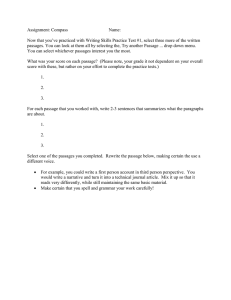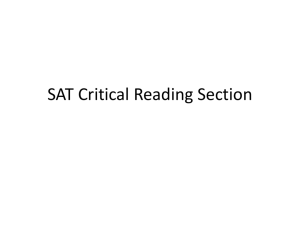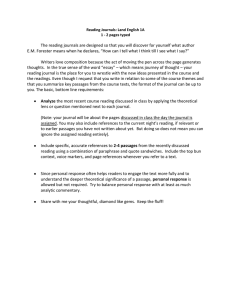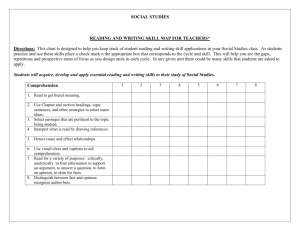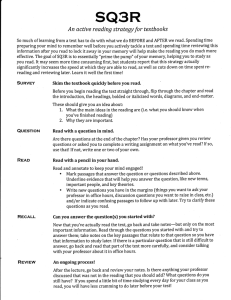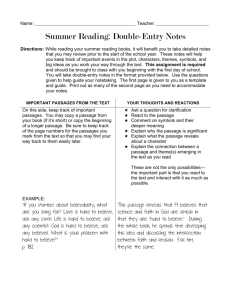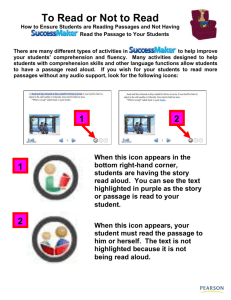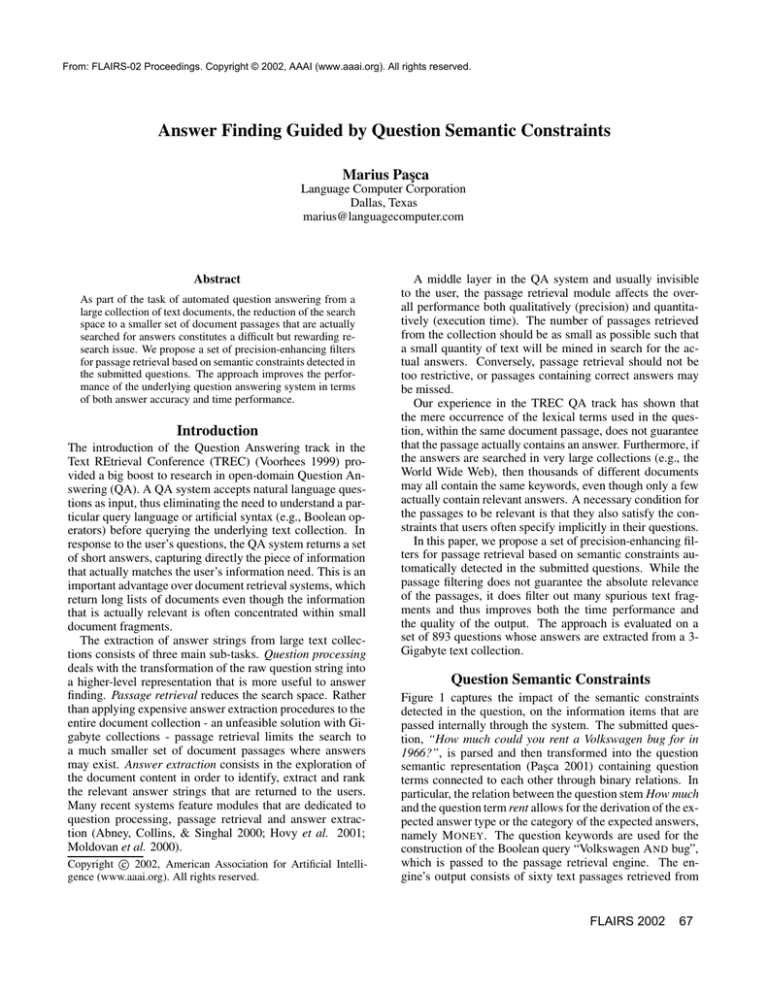
From: FLAIRS-02 Proceedings. Copyright © 2002, AAAI (www.aaai.org). All rights reserved.
Answer Finding Guided by Question Semantic Constraints
Marius Paşca
Language Computer Corporation
Dallas, Texas
marius@languagecomputer.com
Abstract
As part of the task of automated question answering from a
large collection of text documents, the reduction of the search
space to a smaller set of document passages that are actually
searched for answers constitutes a difficult but rewarding research issue. We propose a set of precision-enhancing filters
for passage retrieval based on semantic constraints detected in
the submitted questions. The approach improves the performance of the underlying question answering system in terms
of both answer accuracy and time performance.
Introduction
The introduction of the Question Answering track in the
Text REtrieval Conference (TREC) (Voorhees 1999) provided a big boost to research in open-domain Question Answering (QA). A QA system accepts natural language questions as input, thus eliminating the need to understand a particular query language or artificial syntax (e.g., Boolean operators) before querying the underlying text collection. In
response to the user’s questions, the QA system returns a set
of short answers, capturing directly the piece of information
that actually matches the user’s information need. This is an
important advantage over document retrieval systems, which
return long lists of documents even though the information
that is actually relevant is often concentrated within small
document fragments.
The extraction of answer strings from large text collections consists of three main sub-tasks. Question processing
deals with the transformation of the raw question string into
a higher-level representation that is more useful to answer
finding. Passage retrieval reduces the search space. Rather
than applying expensive answer extraction procedures to the
entire document collection - an unfeasible solution with Gigabyte collections - passage retrieval limits the search to
a much smaller set of document passages where answers
may exist. Answer extraction consists in the exploration of
the document content in order to identify, extract and rank
the relevant answer strings that are returned to the users.
Many recent systems feature modules that are dedicated to
question processing, passage retrieval and answer extraction (Abney, Collins, & Singhal 2000; Hovy et al. 2001;
Moldovan et al. 2000).
­
Copyright c 2002, American Association for Artificial Intelligence (www.aaai.org). All rights reserved.
A middle layer in the QA system and usually invisible
to the user, the passage retrieval module affects the overall performance both qualitatively (precision) and quantitatively (execution time). The number of passages retrieved
from the collection should be as small as possible such that
a small quantity of text will be mined in search for the actual answers. Conversely, passage retrieval should not be
too restrictive, or passages containing correct answers may
be missed.
Our experience in the TREC QA track has shown that
the mere occurrence of the lexical terms used in the question, within the same document passage, does not guarantee
that the passage actually contains an answer. Furthermore, if
the answers are searched in very large collections (e.g., the
World Wide Web), then thousands of different documents
may all contain the same keywords, even though only a few
actually contain relevant answers. A necessary condition for
the passages to be relevant is that they also satisfy the constraints that users often specify implicitly in their questions.
In this paper, we propose a set of precision-enhancing filters for passage retrieval based on semantic constraints automatically detected in the submitted questions. While the
passage filtering does not guarantee the absolute relevance
of the passages, it does filter out many spurious text fragments and thus improves both the time performance and
the quality of the output. The approach is evaluated on a
set of 893 questions whose answers are extracted from a 3Gigabyte text collection.
Question Semantic Constraints
Figure 1 captures the impact of the semantic constraints
detected in the question, on the information items that are
passed internally through the system. The submitted question, “How much could you rent a Volkswagen bug for in
1966?”, is parsed and then transformed into the question
semantic representation (Paşca 2001) containing question
terms connected to each other through binary relations. In
particular, the relation between the question stem How much
and the question term rent allows for the derivation of the expected answer type or the category of the expected answers,
namely M ONEY. The question keywords are used for the
construction of the Boolean query “Volkswagen A ND bug”,
which is passed to the passage retrieval engine. The engine’s output consists of sixty text passages retrieved from
FLAIRS 2002
67
TREC−8 Q013:
How much could you rent a Volkswagen bug for in 1966?
Question stem
Answer type word
Question semantic
How much
Volkswagen representation
rent
1966
Date constraint
bug
Answer type
Money
60 document passages retrieved
from TREC−9 document collection
(approx. 700,000 documents)
Volkswagen AND bug
At 8 a.m., invading a Belmont Shore beach occupied only by a tractor, Morlon Wiley raced
through deep sand with the enthusiasm that defines him. In seconds, he became a speck
on the gray horizon. Returning to the parking lot after that workout last Saturday, Wiley,
22, entered not a luxury car befitting a pro basketball player but a 1966 Volkswagen
black bug he has owned since he was a sophomore at Cal State Long Beach. [...]
Boolean
query
Document
passage
(LA070989−0192)
14 document passages after
"concept specificity" filtering
Some of the village residents offer primitive accommodations for much less. Daily flights
to Cancun from Los Angeles are available on Mexicana and Delta Airlines for about $350
round trip. Nissan Sentras, Volkswagen Bugs and Jeeps can be rented at the Cancun
airport for about $40 a day. Larger cars are significantly more expensive. For more
information on travel to Mexico, contact the Mexican Government Tourism Office [...]
Document
passage
(LA010790−0113)
2 document passages after
"date constraints" filtering
A KFWB news announcer reported that Democratic
gubernatorial candidate Dianne Feinstein will be
running "against Pete Smith." That’s news to Arlo
Wilson. LAny: When Dollar Rent−a−Car opened in
1966, you could rent a Volkswagen bug for $1 a day.
Dollar’s current daily rate for an economy model
is $29.95. Photo, The many faces of John Woodruff:
At Mann’s Chinese Theater, at least, his car
has achieved fame [...]
Document passage
Rank 1: $1
Rank 2: $29.95
$1
(LA060790−0003)
2 Answer candidates
("Money" entities)
Patent lawyers say the nickname doctrine recognizes
that a company has a protected right in a nickname,
even though it has done nothing to promote the
name. [...] Roger Schechter, a trademark professor at
George Washington University’s National Law Center,
says that over the years companies have won the
right to protect nicknames like Coke (Coca−Cola Co.),
Bud (Budweiser), [...] HOG (Harley Davidson Inc.) and
Bug (Volkswagen AG). [...]
Document passage
None
(WSJ910430−0032)
0 Answer candidates
("Money" entities)
Best answer
candidate in
passage
Rank 1: rent a Volkswagen bug for $ 1 a day . Dollar ’s
Answer string(s)
strings (50 byte)
Figure 1: Exploiting question semantic constraints: answering TREC-8 test question Q013
68
FLAIRS 2002
the TREC-9 document collection.
Because the question term rent is deemed to be very specific, all passages which do not contain the term are rejected
after the application of the concept specificity filter. Note
that one of the rejected passages, from the Los Angeles
Times article LA070989-0192, mentions a basketball player
who owns a Volkswagen bug rather than rents it (see Figure 1). Similarly, the absence of the date constraint 1966
from any of the text passages causes the elimination of the
passage. This turns out to be very helpful in rejecting passages such as that from article LA010790-0113, which does
refer to the rental price of Volkswagen bugs, but not the price
from 1966. As a combined effect of the passage semantic filters, the initial set of sixty passages is reduced to only two
passages, both of which are shown in the figure.
The first of the re-ranked, filtered document passages contains two entities of the expected answer type M ONEY, i.e.,
$1 and $29.95. The returned answer strings are extracted
from the text passages around the highest ranking candidate
answer.
Experimental Setting
The experiments involve the standard test collection from
the TREC QA track. The question set consists of factseeking, short-answer questions from the TREC QA track.
There are 200 questions from TREC-8 and 693 questions
from TREC-9, all of which are guaranteed to have at least
one answer in the underlying document collection. The document collection comprises more than 700,000 text documents from sources including Los Angeles Times and Wall
Street Journal.
Individual questions are assigned a score equal to the reciprocal answer rank. The answer rank is the rank of first
correct 50-byte answer returned by the system (Voorhees
1999). Thus a question receives a score of 1, 0.5, 0.33, 0.25,
0.2, if the first correct answer is returned at rank 1, 2, 3, 4
and 5 respectively. By convention, the score for questions
with no correct answer among the first five returned is 0.
The overall accuracy or precision score is the mean of
the reciprocal answer ranks computed over the entire set of
questions. To ensure that the results are relevant to state-ofthe-art QA, we use in our experiments the same QA technology that answered correctly the highest number of questions
in the TREC-8 and TREC-9 QA track evaluations.
Conceptual Filtering
Terms such as rent from Q013: “How much could you rent a
Volkswagen bug for in 1966?”, or wage from Q296: “What
is the federal minimum wage?” play a special role in answer finding. The semantic disambiguation of these terms,
formally called answer type terms, into their corresponding
answer type (M ONEY) relies on the mapping of the question semantic representations onto a lexico-semantic hierarchy of answer types. The passages without any occurrence
of a concept of the expected answer type are discarded as irrelevant. Furthermore, the concepts of the expected answer
type that are also in the proximity of the question terms are
likely to constitute an answer and scored accordingly. When
the semantic disambiguation of answer type terms is enabled, the overall precision of the QA system on the TREC-8
and TREC-9 questions combined improves substantially as
shown in Table 1.
Table 1: Impact of conceptual filtering based on semantically disambiguated answer type terms on QA precision
Filter usage Precision score (893 questions)
Disabled
0.487
Enabled
0.565
The accuracy of the extracted answers can be further enhanced based on concept specificity. The more specific the
answer type terms from the questions are, the more likely
it is for them to occur in similar forms in the relevant answer strings. For Q056: “How many calories are there in
a Big Mac?”, which makes reference to the very specific
answer type term calories, the answer contains the answer
type term: “A Big Mac has 562 calories”. Similarly, in the
case of the question Q013: “How much could you rent a
Volkswagen bug for in 1966?”, the answer contains the term
rent: “in 1966, you could rent a Volkswagen bug for $1 a
day”.
The estimation of whether a concept is specific or not
could rely on the depth of the concept in the WordNet (Miller 1995) hierarchies, or on the coverage of that
concept measured as number of hyponyms - or more specific concepts. After a few experiments, we realized that the
depth alone does not capture concept specificity well, due to
the lack of balance in WordNet hierarchies. Consequently,
we developed an algorithm for specificity computation following the second alternative (Paşca 2001):
Step 1. Identify the question term that determines
the answer type: a-term
Step 2. Take all senses of a-term from
WordNet: aw , i=½ Step 3. For each sense , i=½ 3.1. Collect all hyponyms of in a set 3.2. Remove from those hyponyms containing
answer-word as head word
3.3. Remove from those hyponyms that are proper
nouns (names)
Step 4. Decide upon specificity of a-term
4.1. If card( ) , a-term is specific
4.2. If card( ) , a-term is not specific
The algorithm deems a concept as very specific if it has
few hyponyms in its sub-hierarchy. Note that the algorithm
takes into account (1) the mismatch between the word level
(for answer type terms) and conceptual level (Step 1); (2) the
treatment of compound WordNet concepts during specificity
estimation (Step 3.2); and (3) the blurring of the KindOf and
InstanceOf relations within the WordNet hierarchies (Step
3.3).
Table 2 illustrates the application of passage post-filtering
for three TREC questions with specific answer type terms.
After discarding the retrieved passages that do not contain
FLAIRS 2002
69
Table 2: Discarding irrelevant passages through specificity-based passage filtering
Question (answer type term in italics)
#Passages retrieved
Filter
(Boolean query)
Q043: What costume designer decided that
(Michael Jackson costume) designer
Michael Jackson should only wear one glove?
50
Q230: When did the vesuvius last erupt?
(vesuvius last)
erupt
25
Q231: Who was the president of Vichy France? (Vichy France)
president
129
#Passages
retained
1 (2%)
13 (52%)
51 (39%)
Table 3: Impact of conceptual filtering based on highly specific answer type terms
Question (answer type term in italics)
Precision score:
Precision score:
filter disabled
filter enabled
Q016: What two US biochemists won
0.33 (rank: 3)
1 (rank: 1)
the Nobel Prize in medicine in 1992?
Q168: Who was the captain of the tanker,
0 (rank: not
1 (rank: 1)
Exxon Valdez, involved in the oil spill
first 5)
in Prince William Sound, Alaska, 1989?
Q800: What monarch signed the Magna Carta? 0 (rank: not first 5) 1 (rank: 1)
Q506: Who reports the weather on the
1 (rank: 1)
0 (rank: not first 5)
”Good Morning America” television show?
the answer type term, we obtain a significant reduction over
the number of passages retrieved. For the example from Figure 1, among the 60 passages retrieved by the query (Volkswagen bug), only 14 contain the answer type term rent
which is very specific (it has only one hyponym - a more
specific concept - in WordNet). The 46 passages that are
discarded because they do not contain the specific answer
type represent an important reduction ratio (77%) over the
initial set of 60 retrieved passages. Table 2 shows other questions for which irrelevant passages are successfully filtered
out based on conceptual specificity.
When run on the 893 TREC evaluation questions, the
specificity estimation procedure finds very specific answer
types for 366 questions. In turn, the 366 questions are split
into 258 questions for which the answer type term is already used in the Boolean query for passage retrieval, and
108 questions for which the answer type is not used in the
Boolean query. For the latter 108 questions, the average
number of passages retrieved in the last iteration is 346.
Comparatively, the average number of passages retained after specificity post-filtering is 52, corresponding to a passage
rejection / retention rate of 63%/37%. The strongest filtering occurs for Q830: “What is the equivalent of the Red
Cross in the Middle East?”, for which only 4 out of 409 retrieved passages are retained after post-filtering (99% of the
passages are discarded). On the other hand, no passage is rejected for Q469: “Who coined the term ”cyberspace” in his
novel ”Neuromancer”?” (one passage is retrieved and also
retained). In addition to better time performance after reducing the number of passages, the conceptual filtering based on
answer type term specificity also improves the quality of the
extracted answers. When specificity-based passage filtering
is enabled, the overall precision score increases by 1.7% for
70
FLAIRS 2002
TREC-9 questions only, and 1.5% for TREC-8 and TREC9 questions. The individual precision score changes for 31
questions: it increases for 27, and decreases for 4 questions.
Thus there are few cases (4 out of 366) when the application of the filter actually leads to the extraction of irrelevant
answer strings due to the rejection of all relevant passages.
Table 3 illustrates some of the 31 questions whose score is
affected.
Date Constraints
In addition to specific answer type terms, another type of
semantic constraint that is useful for passage post-filtering
are the date constraints, e.g., “How much could you rent a
Volkswagen bug for in 1966?”. The detection of dates in
the submitted questions is performed with a named entity
recognizer which supports the date and year entity types.
When a date constraint is found in the question, the retrieved
passages are analyzed with the following algorithm:
Step 1. Identify the date constraints from the
question: yearQuestion
Step 2. If there is not exactly one date
yearQuestion, then retain all passages and return
Step 3. For each passage retrieved from the
collection, i=½ 3.1. If yearQuestion occurs as a token in , then
retain 3.2. Else if minCollectionYear yearQuestion maxCollectionYear
3.2.1. Extract creation date for document
containing : yearDoc
3.2.2. If yearDoc yearQuestion then
discard 3.2.3. Else retain (defensive approach)
3.3. Else if yearQuestion minCollectionYear then
discard 3.4. Else discard .
The algorithm correlates the date stamp of each of the
retrieved passages with the date constraint specified in the
question. In the case of TREC documents, this information
appears in the document header. The earliest and the latest
published documents determine the time range of the collection, denoted by minCollectionYear and maxCollectionYear.
Each passage is retained or discarded, depending on the relation between the date of the passage and the date constraint
from the question.
Table 4: Passage filtering based on date constraints
Question
#Passages
retrieved/
discarded/
retained
(pct. retained)
Q036: In 1990, what day of the
496/393/103
week did Christmas fall on ?
(21%)
Q040: Who won the Nobel
1133/991/142
Peace Prize in 1991?
(13%)
Q063: What nuclear-powered
23/16/7
Russian submarine sank in the
(30%)
Norwegian Sea on April 7, 1989?
Q103: How many people died
259/201/58
when the Estonia sank in 1994?
(22%)
As shown in Table 4, verifying the date constraints is another source of semantic information that is very useful for
refining the output from the passage retrieval engine. When
run on the 200 evaluation questions from the TREC-8 QA
track, the algorithm identifies 25 questions containing date
constraints. The precision score of the system changes for
5 out of the 25 TREC-8 questions, when verification of date
constraints is enabled. The precision scores change as follows: 0.2 to 0.5 for Q004, 0.33 to 1 for Q016, 0.2 to 0.5 for
Q036, 0.5 to 1 for Q040, and 0 to 0.25 for Q169. From a
total of 6017 passages retrieved for the 25 questions, 1220
passages are retained after post-filtering based on date constraints. This corresponds to an average of 80% passages
being discarded, per question specifying a date contraint.
Consequently, the answer extraction module has to process
fewer passages and runs 45% faster. The impact of date constraints is negligible on the TREC-9 questions, because only
4 out of the 693 evaluation questions specify a date constraint, e.g., Q242: “What was the name of the famous battle
in 1836 between Texas and Mexico?”.
are actually searched for answers. Previous approaches
acknowledge the usefulness of the question’s answer type
in answer extraction (Abney, Collins, & Singhal 2000;
Hovy et al. 2001). However, to our knowledge there is no
recent work focusing on semantic refinements of passage retrieval for large-scale, open-domain QA.
Our approach is specifically designed for large-scale QA
systems. Nevertheless, it can be easily extended to any
precision-oriented information retrieval system that accepts
natural language input, even if the output is not a set of answers but larger text excerpts.
References
Abney, S.; Collins, M.; and Singhal, A. 2000. Answer extraction.
In Proceedings of the 6th Applied Natural Language Processing
Conference (ANLP-2000), 296–301.
Hovy, E.; Gerber, L.; Hermjakob, U.; Lin, C.; and Ravichandran,
D. 2001. Toward semantics-based answer pinpointing. In Proceedings of the Human Language Technology Conference (HLT2001).
Miller, G. 1995. WordNet: a lexical database. Communications
of the ACM 38(11):39–41.
Moldovan, D.; Harabagiu, S.; Paşca, M.; Mihalcea, R.; Gı̂rju, R.;
Goodrum, R.; and Rus, V. 2000. The structure and performance
of an open-domain question answering system. In Proceedings
of the 38th Annual Meeting of the Association of Computational
Linguistics (ACL-2000).
Paşca, M. 2001. High-Performance, Open-Domain Question Answering from Large Text Collections. Ph.D. Dissertation, Southern Methodist University, Dallas, Texas.
Voorhees, E. 1999. The TREC-8 Question Answering track report. In Proceedings of the 8th Text REtrieval Conference (TREC8), 77–82. Gaithersburg, Maryland: NIST.
Conclusions
This paper presented a method for enhancing the precision
of a large-scale QA system based on advanced processing
of natural language questions. The method exploits the information extracted automatically from the submitted questions in order to filter the retrieved passages, before they
FLAIRS 2002
71

